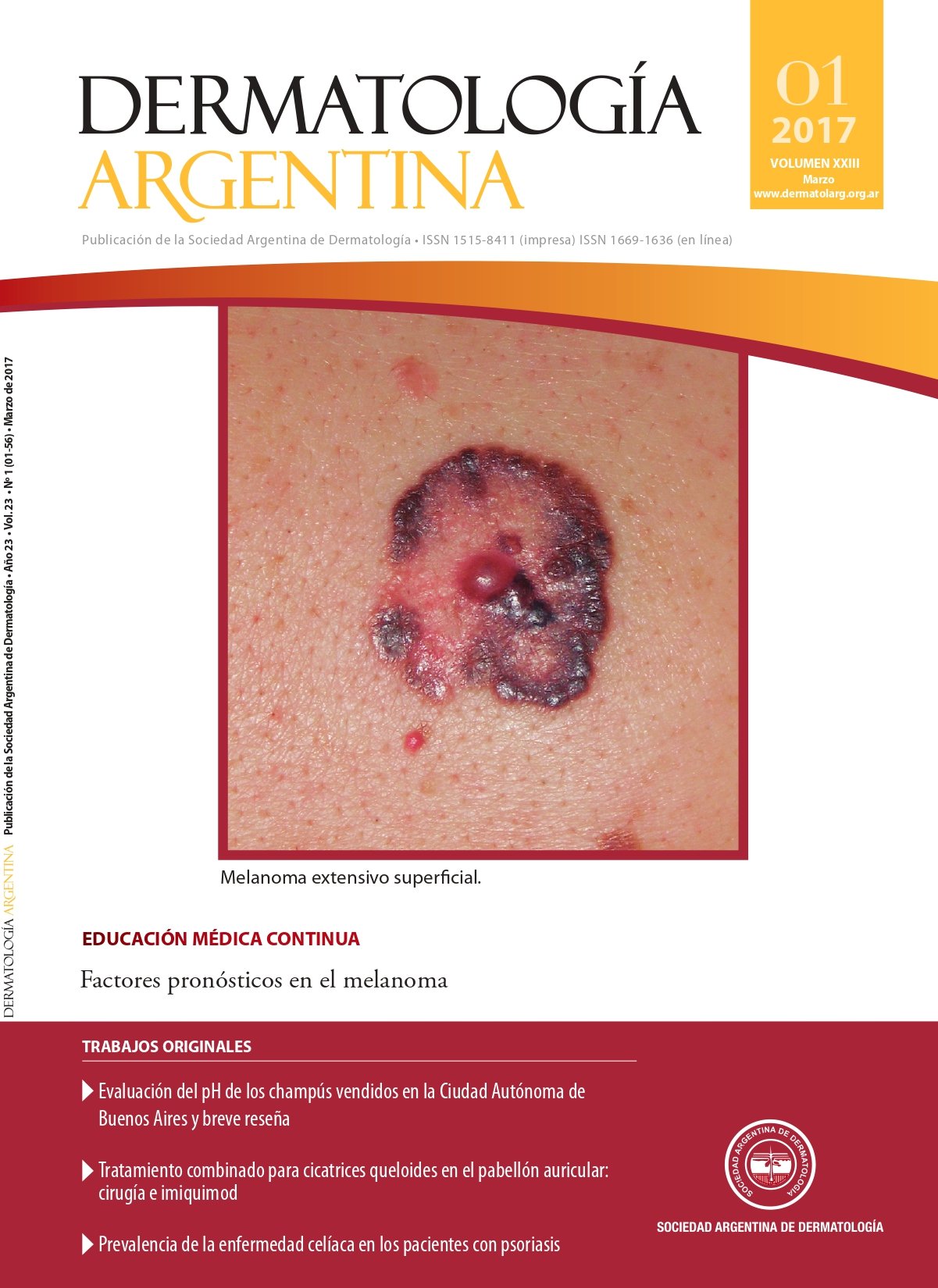Combined treatment for keloids scars in pinna: surgery and imiquimod
Keywords:
pinna, keloids , imiquimodAbstract
Keloids are excessive fibrous growths of skin tissue, occurring in predisposed patients appear after trauma, wound, piercing, burns or an inflammatory process in the skin. They represent a challenge for the physician, because there is no therapeutic modality of choice for their high rates of recurrence after treatment. The combination of different techniques, both surgical and non surgical shows better results.
Objective: to evaluate the efficacy of treatment of keloids in pinna by combining techniques of excision and imiquimod.
Materials and methods: a retrospective study of patients evaluated in the Department of Dermatology at Alvarez Hospital between January 2009 and December 2012, with clinical diagnosis of keloid in pinna.
Results: eight keloids were selected in 6 patients, where surgery was performed: 6 simple mode losange and primary closure (75%); the remaining 2 with shaving and close by secondary intention (25%). Subsequently applying imiquimod 5% cream three times per week is indicated for a period of 6 months. No recurrence was present in five keloids after a period of 24 months follow-up.
Conclusions:we believe that the combined use of excision and imiquimod are a safe and effective form of treatment, with good aesthetic results and few side effects.
References
I. Shockman S, Paghdal KV, Cohen G. Medical and surgical ma-nagement of keloids: a review. J Drugs Dermatol 2010;9:1249-1257.
II. Valerón-Almazán P, Dehesa-García L, Vilar Alejo J, Domín-guez-Silva J, et ál. Tratamiento quirúrgico del queloide recidi-vante de pabellón auricular mediante “colgajo en filete”. Actas Dermosifiliogr 2010;101:235-241.
III. Stashower ME. Successful treatment of earlobe keloids with imiquimod after tangential shave excision. Dermatol Surg2006;32:380-386.
IV. Martin-García RF, Busquets AC. Postsurgical use of imiqui-mod 5% cream in the prevention of earlobe keloid recu-rrences: results of an open-label, pilot study. Dermatol Surg2005;31:1394-1398.
V. Berman B, Kaufman J. Pilot study of the effect of postopera-tive imiquimod 5% cream on the recurrence rate of excised keloids. J Am Acad Dermatol 2002;47:S209-S211.
VI. Berman B, Villa A. Imiquimod 5% cream for keloid manage-ment. Dermatol Surg 2003;29:1050-1051.
VII. Patel PJ, Skinner Jr RB. Experience with keloids after exci-sion and application of 5% imiquimod cream. Dermatol Surg2006;32:462.
VIII. Chuangsuwanich A, Gunjittisomrarn S. The efficacy of 5% imiquimod cream in the prevention of recurrence of excised keloids. J Med Assoc Thai 2007;90:1363-1367.
IX. Blanco Barrios S, Roncero Riesco M, Unamuno Pérez P. Queloi-de en hélix: excelente respuesta al tratamiento con imiquimod después del afeitado de la lesión. Piel 2009;24:164-165.
X. Marson Cação F, Tanaka V, De Lourenzo Messina MC. Failure of imiquimod 5% cream to prevent recurrence of surgically exci-sed trunk keloids. Dermatol Surg 2009;35:629-633.
XI. Malhotra AK, Gupta S, Khaitan BK, Sharma VK. Imiquimod 5% cream for the prevention of recurrence after excision of pres-ternal keloids. Dermatology 2007;215:63-65.
XII. Berman B, Harrison-Balestra C, Perez OA, Viera M, et ál. Treat-ment of keloid scars post-shave excision with imiquimod 5% cream: a prospective, double-blind, placebo-controlled pilot study. J Drugs Dermatol 2009;8:455-458.
Downloads
Published
Issue
Section
License
Copyright (c) 2017 Argentine Society of Dermatology

This work is licensed under a Creative Commons Attribution-NonCommercial-NoDerivatives 4.0 International License.
El/los autor/es tranfieren todos los derechos de autor del manuscrito arriba mencionado a Dermatología Argentina en el caso de que el trabajo sea publicado. El/los autor/es declaran que el artículo es original, que no infringe ningún derecho de propiedad intelectual u otros derechos de terceros, que no se encuentra bajo consideración de otra revista y que no ha sido previamente publicado.
Le solicitamos haga click aquí para imprimir, firmar y enviar por correo postal la transferencia de los derechos de autor











